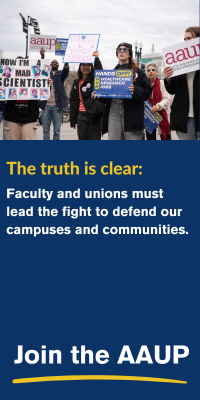- About
- Programs
- Issues
- Academic Freedom
- Political Attacks on Higher Education
- Resources on Collective Bargaining
- Shared Governance
- Campus Protests
- Faculty Compensation
- Racial Justice
- Diversity in Higher Ed
- Financial Crisis
- Privatization and OPMs
- Contingent Faculty Positions
- Tenure
- Workplace Issues
- Gender and Sexuality in Higher Ed
- Targeted Harassment
- Intellectual Property & Copyright
- Civility
- The Family and Medical Leave Act
- Pregnancy in the Academy
- Publications
- Data
- News
- Membership
- Chapters
Required Reading for Transformational Leaders

Higher Education Leadership: Challenging Tradition and Forging Possibilities by Rozana Carducci, Jordan Harper, and Adriana Kezar. Johns Hopkins University Press, 2024.
The authors of Higher Education Leadership: Challenging Tradition and Forging Possibilities confront the forces of neoliberalism and white supremacy, which persist as dominant ideologies in higher education. Grounded in theory and research, this textbook dives into contemporary issues in higher education leadership, including faculty workload, academic freedom, and shared governance. It is thus tailored to scholar-practitioners who strive to be unapologetic about employing critical leadership perspectives that are inherently antiracist, identity-centered, advocacy-oriented, and equity-minded for the purpose of dismantling systems of oppression.
The text is organized in three sections: the contemporary context of leadership in higher education; perspectives on leadership research and practice; and leadership for liberation. In the first section, the authors push back against traditional perspectives of leadership, which are frequently based on the characteristics and actions of white, upper-middle-class men. For example, chapter 1 opens with a powerful vignette that captures the “complexity of systemic oppression and racial hostility” that led to the removal of the former University of Missouri system president and campus chancellor after students, faculty members, and administrators protested the institution’s lack of response to racial tensions following the police killing of Michael Brown in nearby Ferguson. The authors question the practice of top-down leadership by providing scholarly evidence of equity-driven and socially just leadership practices that center marginalized communities, and they call for a redefinition of leadership from individual to collaborative action.
In chapter 2, the authors open with a story about a PhD student, Michelle, a queer Black woman interested in investigating Black women’s leadership styles in academic institutions defined by implicit bias and overt racism. While centering Michelle’s lived experience, they examine five specific paradigms that influence higher education leadership: postpositivist leadership, social constructivist leadership, critical leadership, postmodernist leadership, and participatory leadership. The authors draw attention to leadership research, which has frequently opposed efforts to dismantle oppressive institutions and structures connected with neoliberalism and white supremacy. By contrast, critical, postmodern, and participatory perspectives help advance a more equitable landscape.
Chapter 3 discusses how neoliberal ideology has restructured higher education with pervasive effects on faculty workload, especially for those holding contingent appointments. The authors describe the “gig academy” as an example of academic capitalism in which practically all employees (faculty, staff, postdoctoral researchers, and students) are contingent. They criticize this structural shift, emphasizing that it directly contrasts with the public-good orientation of higher education. Drawing from mounting evidence in scholarship centered on neoliberalism and academic capitalism, this chapter is a must-read for anyone looking to preserve academic quality and integrity while humanizing the working conditions of the academy.
In chapter 4, the authors delve into whiteness and white supremacy in higher education leadership. They frame their perspective by discussing the experience of Nikole Hannah-Jones, creator and lead author of The New York Times Magazine’s 1619 Project, a revisionist journalistic initiative centering the lives, perspectives, and realities of enslaved people and their roles in shaping the founding of the United States. After faculty members of the Hussman School of Journalism and Media at the University of North Carolina at Chapel Hill recommended Hannah-Jones’s appointment with tenure as the Knight Chair in Race and Investigative Reporting, the UNC board of trustees chose not to vote on the recommendation. The authors of Higher Education Leadership contend that the trustees upheld the status quo in their decision-making under pressure from an influential donor who objected to the proposed appointment. Following protests by UNC’s Black faculty, media scrutiny, and the threat of a lawsuit from the NAACP, the UNC board of trustees eventually granted tenure to Hannah-Jones, but she refused the offer and instead accepted a position as inaugural Knight Chair in Race and Journalism at the Howard University School of Communications. In the context of the controversy surrounding this episode, the authors note that whiteness is a system and structure with material benefits. They argue that higher education carries the weight of plantation logics and principles that privilege whiteness, hierarchies, power, control, and order.
Chapter 5 addresses the paradigm of transformational leadership, which has brought crucial concepts like ethics, social change, and empowerment into the leadership lexicon. The authors illustrate these concepts through the story of LeShaun, a student-affairs professional who leads a service-learning program. The program’s community partners, who are people of color, request payment for their work and more input into the curriculum. Notably, the students are predominantly white. This contrast helps LeShaun understand the importance of fostering greater reciprocity in service-learning relationships, and he collaborates with the staff and faculty to develop a new vision for the program based on a reciprocal model. However, the vice president of student affairs notes that there is no budget to support this initiative, creating a barrier for LeShaun. The authors emphasize that leadership should be both transformational and humane. This vision calls for leadership to be more experimental—challenging and disrupting existing systems, encouraging diverse viewpoints, and reducing hierarchical structures.
In chapters 6 and 7, the authors explore “cognitive leadership perspectives” and “chaos and complexity leadership perspectives,” offering guidance for current and aspiring higher education leaders. They emphasize that leaders interested in advancing equity must engage in structured reflection and dialogue to confront and address their cognitive biases, which influence their decisions and interactions. As an example, in chapter 6, they discuss a search to replace the president of the pseudonymous Green Valley State College, who had resigned after twelve years of service. The board of trustees collaborated with a search firm to identify two finalists for the position. The first candidate was a white male, Mark Simon, who had a business background and twelve years of experience as a state senator. The second candidate was Linda Martinez, a Latina woman who had advanced through the academic ranks and served as a provost at a historically Black institution. The board ultimately selected the white male, leading the only Black woman trustee to resign in protest, citing objections to the race and gender biases used in evaluating the candidates’ leadership experience and style. The authors describe this as a leadership selection controversy, noting that a cultural shift in understandings of leadership is essential to foster transformative learning experiences. They advocate for leaders to challenge and dismantle institutional hierarchies that often hinder the public-good mission of higher education and argue that leaders must embrace an abolitionist, anti-neoliberal, and anti–white supremacist mindset to effectively navigate and transform oppressive systems.
In chapters 8 and 9, the authors discuss the importance of leadership styles in higher education. In chapter 8, they explain the influence of factors like history, identity, and culture on leadership: Cisgender women often lead in a more collaborative and relationship-focused way, emphasizing teamwork and mutual support, while racialized minorities also have leadership styles shaped by their specific experiences. For example, the authors discuss how Linda Martinez, one of the candidates for the presidency of Green Valley State College, highlighted in her interview her involvement with a public health institute while serving as provost of a historically Black college. The curriculum of the public health institute—informed by the principles of applied critical leadership—helped Martinez to “recognize the ways her race, ethnicity, gender, socioeconomic class, immigration status, and other salient social identities have shaped her leadership experiences and approach to facilitating change.” She shifted from a hierarchical model and decentralized decision-making to a style emphasizing collaboration, open communication, and consensus-based decisions. The authors note that this approach holds promise for contesting and dismantling the twin ideologies of neoliberalism and white supremacy.
Chapter 9 shifts to processual leadership, which focuses on how leadership is a shared process that changes over time based on the situation. The authors point out that processual leadership research shifts the focus from individual, hierarchical leadership to collective engagement that depends on context and evolves over time. They offer two critiques: first, the need for a deeper consideration of power and oppression within leadership processes and, second, the methodological challenges in studying these complex processes. They argue that leadership is influenced by individuals’ commitment to various systems, structures, and ideologies, and processual leadership should reflect this reality. Additionally, they highlight obstacles such as navigating administrative barriers and the need for extended fieldwork, which complicate the study of leadership in real time. Therefore, the authors recommend that researchers ensure that they have sufficient time and financial resources to conduct studies of leadership processes as required by processual leadership theory. In chapter 10, the authors offer recommendations for the future of leadership practices and research. They point out that, although more scholars are pushing for leadership research to adopt critical and postmodern perspectives, progress has been slow in the movement away from neoliberal and white supremacist assumptions in higher education leadership studies. They suggest several important principles for leadership, such as prioritizing people over profit, focusing on equity, and centering liberation, social justice, and humanization. The authors also highlight the significance of transformational, cognitive, and cultural leadership and introduce new leadership theories. They conclude by arguing that the direction of leadership in higher education can change through critical self-reflection and ongoing examination of current practices.
This book should be required reading for higher education scholars, practitioners, and institutional leaders who want transformational change in higher education. It is for everyone who is ready to push back against the status quo and elevate equity-driven and socially just perspectives. Amid increasingly tumultuous times in higher education, every postsecondary educator should apply some of these much-needed leadership principles in order to demonstrate outright commitment to students at the margins.
Arsene Frederic Jr. is a doctoral student in his fourth year of the Higher Education Leadership and Policy Studies PhD program at Howard University’s School of Education. His email address is [email protected]. Jorge Burmicky is assistant professor of higher education leadership and policy studies at Howard University. His email address is [email protected].



